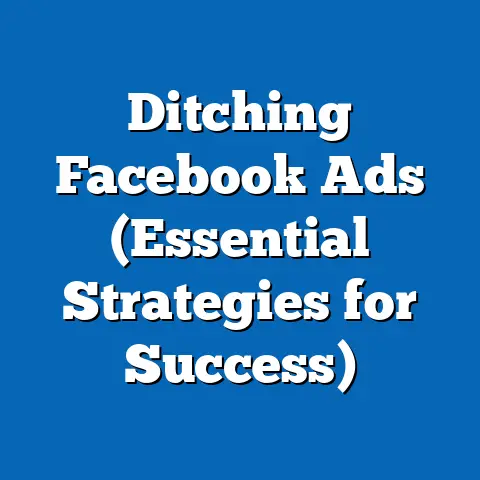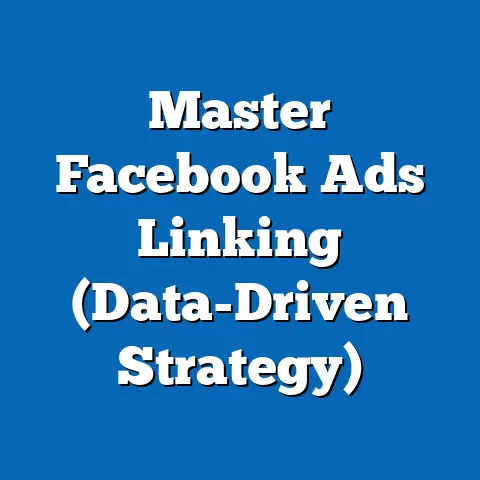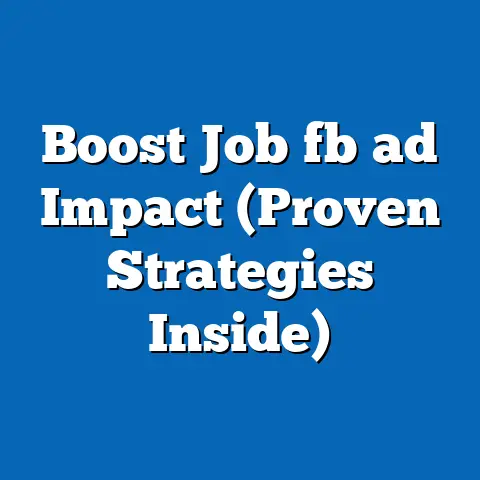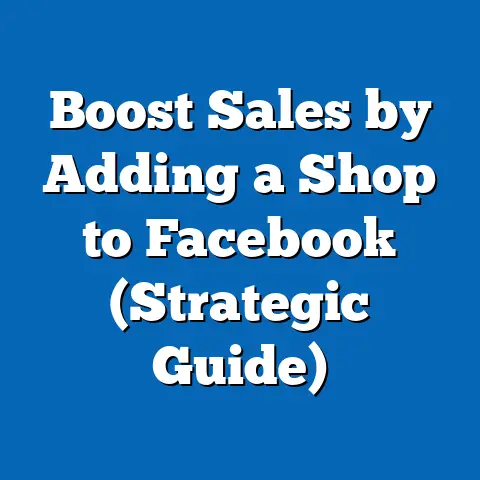Target Journalists with Facebook Ads (Strategic Insights)
In the bustling landscape of media and journalism, where every headline competes for attention like bursts of color in a painter’s palette, brands need to stand out to reach their desired audience. For years, I’ve seen companies struggle to get their stories heard, relying on outdated tactics that simply don’t cut through the noise anymore. That’s where Facebook advertising comes in – not just as another platform, but as a strategic tool to connect directly with journalists who can amplify your message.
I remember one particular client, a tech startup with a groundbreaking new product, who was frustrated with their lack of media coverage. They’d sent countless press releases, but nothing seemed to stick. It was then I suggested we try something different: a targeted Facebook ad campaign aimed specifically at tech journalists. The results were astounding. Within weeks, they landed interviews with major publications, all thanks to the focused approach of Facebook Ads.
This article isn’t just about running ads; it’s about understanding the unique world of journalism and crafting a strategy that resonates with the professionals who shape the news. I’ll guide you through the process, from understanding the journalist landscape to measuring your success. Let’s dive in!
Understanding the Journalist Landscape
Before you even think about crafting an ad, you need to understand who you’re trying to reach. Journalists aren’t a monolithic group; they come in many forms and play diverse roles in the modern media ecosystem.
Who Are Journalists?
In today’s media landscape, “journalist” encompasses a broad spectrum of roles, each with its own distinct function and influence:
- Reporters: These are the boots on the ground, the individuals who gather information, conduct interviews, and write the stories that inform the public. They might specialize in a particular beat like politics, business, technology, or culture.
- Editors: Editors are the gatekeepers, responsible for reviewing and refining the content produced by reporters. They ensure accuracy, clarity, and adherence to the publication’s standards. They also play a crucial role in shaping the narrative and deciding which stories get published.
- Columnists and Opinion Writers: These individuals provide commentary and analysis on current events, offering their unique perspectives and often sparking debate. They have a dedicated following and can significantly influence public opinion.
- Freelance Journalists: Working independently, these journalists pitch stories to various publications and often specialize in niche topics. They are valuable because they can offer specialized knowledge and reach specific audiences.
- Influencers with Journalistic Integrity: With the rise of social media, some influencers are now operating as citizen journalists, reporting on events and issues through their platforms. While not traditionally trained, some adhere to journalistic ethics and can reach vast audiences.
Understanding these different roles is crucial because it allows you to tailor your message to the specific interests and needs of each group. An editor, for example, might be more interested in the overall quality and relevance of your story, while a reporter might be more focused on the factual details and potential for compelling narratives.
The Changing Dynamics of Journalism in the Digital Age
The digital age has fundamentally transformed the way journalists work and consume information. Social media has become an integral part of their workflow, serving as a source of news, a platform for connecting with sources, and a tool for disseminating their work.
- Social Media as a News Source: Journalists routinely use platforms like Facebook and Twitter to monitor breaking news, track trends, and find potential story leads. A significant portion of news breaks first on social media before being picked up by traditional outlets.
- Direct Engagement with Audiences: Social media allows journalists to engage directly with their audience, solicit feedback, and build a personal brand. This direct interaction can lead to a more loyal following and greater influence.
- Increased Reliance on Data and Analytics: Digital tools provide journalists with access to vast amounts of data and analytics, which they can use to support their reporting and identify trends. Data-driven journalism is becoming increasingly prevalent.
- The Rise of Citizen Journalism: Social media has empowered ordinary citizens to report on events and issues, blurring the lines between professional and amateur journalism. This has led to a more diverse and participatory media landscape.
Key Characteristics of Journalists as a Target Audience
To effectively target journalists with Facebook ads, you need to understand their unique characteristics as a target audience:
- Demographics: Journalists tend to be highly educated, with a strong interest in current events, politics, and social issues. They are often early adopters of technology and active users of social media.
- Interests: Their interests are broad and varied, but typically include news, media, technology, politics, business, culture, and specific niche topics related to their beat. They are avid readers and consumers of information.
- Online Behavior: Journalists are highly active online, spending a significant amount of time on social media, news websites, and industry blogs. They are likely to follow other journalists, media outlets, and thought leaders in their field.
- What They Look For in a Story: Journalists are always on the lookout for compelling stories that are newsworthy, relevant to their audience, and supported by credible evidence. They appreciate data-driven insights, exclusive information, and unique perspectives. They also value accuracy, objectivity, and ethical reporting.
Takeaway: Understanding the journalist landscape is the foundation of a successful Facebook ad campaign. By knowing who journalists are, how they work, and what they look for, you can craft a message that resonates with them and increases your chances of securing media coverage.
Why Facebook Ads?
With so many platforms and outreach methods available, you might wonder why Facebook Ads are particularly effective for targeting journalists. The answer lies in Facebook’s unparalleled reach, sophisticated targeting capabilities, and potential for direct engagement.
Unique Advantages of Facebook for Targeting Journalists
- Extensive Reach: Facebook boasts billions of active users, including a significant segment of journalists and media professionals. This vast reach allows you to connect with a large number of potential contacts in a single campaign.
- Robust Targeting Capabilities: Facebook’s targeting options are incredibly granular, allowing you to target journalists based on their interests, demographics, behaviors, and even their job titles. This level of precision ensures that your ads are seen by the right people.
- Detailed Analytics: Facebook provides detailed analytics on your ad campaigns, allowing you to track key metrics like impressions, clicks, engagement, and conversions. This data helps you understand what’s working and what’s not, so you can continually optimize your campaigns for better results.
- Direct Engagement: Facebook allows you to engage directly with journalists through comments, likes, and shares. This direct interaction can help you build relationships and establish yourself as a valuable source of information.
Facebook Ads vs. Traditional Outreach Methods
Traditional outreach methods, like email pitches and press releases, are often ineffective in the digital age. Journalists are bombarded with these types of communications and often ignore them due to their generic nature and lack of relevance.
Facebook Ads offer several advantages over traditional methods:
- Immediacy: Facebook Ads are seen instantly by your target audience, unlike email pitches that can languish in inboxes for days or weeks.
- Engagement: Facebook Ads are designed to be engaging, with visuals, videos, and interactive elements that capture attention and encourage interaction.
- Targeted Reach: Facebook Ads allow you to target journalists with laser precision, ensuring that your message is seen by the people who are most likely to be interested.
- Measurable Results: Facebook Ads provide detailed analytics on your campaign performance, allowing you to track your ROI and make data-driven decisions.
Facebook’s User Base: The Numbers
To understand the potential of Facebook for reaching journalists, let’s look at some key statistics:
- Facebook has over 2.9 billion monthly active users worldwide.
- A significant percentage of journalists and media professionals are active on Facebook, using the platform for news gathering, networking, and self-promotion.
- Facebook’s user base is diverse, spanning a wide range of demographics, interests, and professions. This diversity allows you to target journalists working in various fields and covering different topics.
I once ran a campaign for a client in the renewable energy sector, specifically targeting environmental journalists. Using Facebook’s interest-based targeting, we reached a highly engaged audience of writers and editors who were genuinely interested in the topic. This resulted in several high-profile articles and a significant boost in brand awareness for the client.
Takeaway: Facebook Ads offer a powerful and effective way to target journalists, providing unparalleled reach, sophisticated targeting capabilities, and potential for direct engagement. By leveraging these advantages, you can cut through the noise and connect with the media professionals who can help you amplify your message.
Crafting the Perfect Message
The most sophisticated targeting in the world won’t matter if your ad message falls flat. To resonate with journalists, your ad needs to be clear, relevant, and offer a compelling value proposition.
Essential Elements of a Compelling Ad Message
- Clarity: Your message should be easy to understand and free of jargon. Journalists are busy people, so get straight to the point and clearly communicate the value you’re offering.
- Relevance: Your ad should be relevant to the interests and needs of journalists. Show that you understand their work and the challenges they face.
- Value Proposition: Your ad should offer something of value to journalists, whether it’s exclusive information, data-driven insights, or access to experts. Give them a reason to click on your ad and learn more.
- Credibility: Establish your credibility by highlighting your expertise, experience, and track record. Show that you’re a reliable source of information.
- Compelling Visuals: Use high-quality images or videos that capture attention and convey your message effectively. Visuals are especially important on Facebook, where users are bombarded with content.
What Journalists Appreciate in Ad Content
- Data-Driven Insights: Journalists love data, so include statistics, research findings, and other data-driven insights in your ad content. This will help you establish your credibility and provide them with valuable information for their stories.
- Industry Trends: Stay up-to-date on the latest industry trends and incorporate them into your ad content. This will show journalists that you’re knowledgeable and forward-thinking.
- Thought Leadership Pieces: Share your unique perspectives and insights on relevant topics. This will position you as a thought leader in your industry and attract the attention of journalists who are looking for expert commentary.
- Exclusive Information: Offer journalists access to exclusive information, such as embargoed press releases or early access to new products or services. This will give them a competitive edge and make them more likely to cover your story.
Examples of Successful Facebook Ad Campaigns Targeting Journalists
Let’s examine a few examples of successful Facebook ad campaigns that targeted journalists:
- Example 1: A tech company promoting a new cybersecurity report:
- Ad Copy: “Exclusive Data: New Cybersecurity Threats Facing Businesses. Download our free report to get the latest insights and protect your organization.”
- Visual: A professional-looking graphic featuring key statistics from the report.
- Targeting: Cybersecurity journalists, technology reporters, and business editors.
- Why it worked: The ad offered valuable, data-driven information that was relevant to journalists covering cybersecurity. The free report provided a compelling incentive to click and learn more.
- Example 2: A PR agency promoting a new client in the healthcare industry:
- Ad Copy: “Meet Dr. Smith, a leading expert in [Specific Healthcare Area]. Available for interviews and commentary on the latest healthcare trends.”
- Visual: A professional headshot of Dr. Smith.
- Targeting: Healthcare journalists, medical reporters, and science editors.
- Why it worked: The ad introduced a credible expert who was available for interviews, making it easy for journalists to find sources for their stories. The ad also highlighted the expert’s specific area of expertise, ensuring that it was relevant to the target audience.
- Ad Copy: “Exclusive Data: New Cybersecurity Threats Facing Businesses. Download our free report to get the latest insights and protect your organization.”
- Visual: A professional-looking graphic featuring key statistics from the report.
- Targeting: Cybersecurity journalists, technology reporters, and business editors.
- Why it worked: The ad offered valuable, data-driven information that was relevant to journalists covering cybersecurity. The free report provided a compelling incentive to click and learn more.
- Ad Copy: “Meet Dr. Smith, a leading expert in [Specific Healthcare Area]. Available for interviews and commentary on the latest healthcare trends.”
- Visual: A professional headshot of Dr. Smith.
- Targeting: Healthcare journalists, medical reporters, and science editors.
- Why it worked: The ad introduced a credible expert who was available for interviews, making it easy for journalists to find sources for their stories. The ad also highlighted the expert’s specific area of expertise, ensuring that it was relevant to the target audience.
Takeaway: Crafting the perfect message for journalists requires a deep understanding of their needs and preferences. By focusing on clarity, relevance, and value, you can create ads that capture their attention and encourage them to learn more about your brand.
Targeting Strategies
Facebook’s targeting options are a key differentiator, allowing you to reach journalists with unparalleled precision. Let’s explore some of the most effective targeting strategies for this audience.
Interest Targeting
Interest targeting allows you to reach people based on their expressed interests and hobbies. Here are some specific interests that are relevant to journalists:
- Journalism: This is the most obvious interest to target, as it directly reaches people who are interested in the field.
- News: Target people who are interested in news in general.
- Specific News Outlets: Target people who are interested in specific news outlets, such as The New York Times, The Wall Street Journal, or CNN.
- Specific Topics: Target people who are interested in specific topics related to your industry, such as technology, business, healthcare, or politics.
- Media: Target people who are interested in media in general.
Behavioral Targeting
Behavioral targeting allows you to reach people based on their online behavior, such as their engagement with media content or participation in relevant events. Here are some specific behaviors that are relevant to journalists:
- Engagement with Media Content: Target people who have engaged with media content on Facebook, such as liking, sharing, or commenting on news articles.
- Participation in Relevant Events: Target people who have attended or expressed interest in relevant events, such as journalism conferences or industry trade shows.
- Job Titles: Target people who have listed job titles related to journalism, such as “Reporter,” “Editor,” or “Journalist.”
- Employer: Target people who work for specific media outlets or news organizations.
Custom Audiences
Custom audiences allow you to create targeted lists based on your existing contacts, website visitors, or app users. Here are some ways to create custom audiences for targeting journalists:
- Existing Contacts: Upload a list of email addresses or phone numbers of journalists you’ve previously contacted.
- Website Visitors: Create a custom audience of people who have visited your website, particularly those who have visited your press page or blog.
- Newsletter Subscribers: Create a custom audience of people who have subscribed to your newsletter.
I’ve found that custom audiences, when built carefully, are incredibly powerful. For instance, I once worked with a travel company that wanted to connect with travel journalists. We created a custom audience of journalists who had visited their website and downloaded their press kit. This highly targeted audience was much more responsive to our ads than a broader interest-based audience.
Retargeting Strategies
Retargeting allows you to re-engage journalists who have interacted with your previous ads or content. This is a highly effective strategy because it targets people who are already familiar with your brand.
- Retarget Website Visitors: Show ads to journalists who have visited your website but haven’t yet converted (e.g., downloaded your press kit or contacted you).
- Retarget Ad Engagers: Show ads to journalists who have engaged with your previous ads, such as liking, sharing, or commenting.
- Retarget Video Viewers: Show ads to journalists who have watched your videos on Facebook.
Takeaway: Facebook’s targeting options are a powerful tool for reaching journalists. By combining interest targeting, behavioral targeting, custom audiences, and retargeting strategies, you can create highly targeted campaigns that deliver results.
Budgeting and Ad Formats
Once you’ve crafted your message and defined your target audience, it’s time to set your budget and choose the right ad formats. These decisions will significantly impact the reach and effectiveness of your campaign.
Budgeting Options
Facebook offers several budgeting options to suit different needs and goals:
- Daily Budget: Set a daily budget to control how much you spend each day. This is a good option if you want to run your ads continuously over a long period.
- Lifetime Budget: Set a lifetime budget to control how much you spend over the entire duration of your campaign. This is a good option if you have a specific budget in mind and want to ensure that you don’t exceed it.
- Bidding Strategies: Facebook offers several bidding strategies to help you optimize your ad spend. These include:
- Lowest Cost: Facebook will automatically bid to get you the lowest possible cost per result.
- Cost Cap: You set a maximum cost per result that you’re willing to pay.
- Target Cost: You set a target cost per result that you’re aiming for.
- Value Optimization: Facebook will optimize your bids to get you the highest possible value for your ad spend.
- Lowest Cost: Facebook will automatically bid to get you the lowest possible cost per result.
- Cost Cap: You set a maximum cost per result that you’re willing to pay.
- Target Cost: You set a target cost per result that you’re aiming for.
- Value Optimization: Facebook will optimize your bids to get you the highest possible value for your ad spend.
Best Ad Formats for Engaging Journalists
The ad format you choose can significantly impact the engagement and effectiveness of your campaign. Here are some of the best ad formats for engaging journalists:
- Video Ads: Video ads are highly engaging and can be used to tell compelling stories, showcase your expertise, or provide valuable information.
- Carousel Ads: Carousel ads allow you to showcase multiple images or videos in a single ad. This is a good option for showcasing case studies, articles, or product features.
- Lead Generation Ads: Lead generation ads allow you to collect leads directly from Facebook. This is a good option for offering valuable resources, such as white papers or e-books, in exchange for contact information.
- Image Ads: Image ads are simple and effective for capturing attention and conveying your message quickly.
A/B Testing Ad Formats and Messages
A/B testing involves creating multiple versions of your ad and testing them against each other to see which performs best. This is an essential practice for optimizing your campaign and maximizing your ROI.
- Test Different Ad Formats: Experiment with different ad formats to see which resonates best with your target audience.
- Test Different Messages: Try different headlines, ad copy, and calls to action to see which generates the most clicks and conversions.
- Test Different Visuals: Use different images and videos to see which captures the most attention and conveys your message effectively.
Takeaway: Budgeting and ad formats are crucial components of a successful Facebook ad campaign. By carefully considering your options and A/B testing different approaches, you can optimize your ad spend and maximize your ROI.
Measuring Success
The final step in any Facebook ad campaign is measuring your success. This involves tracking key performance indicators (KPIs) and analyzing your results to determine what’s working and what’s not.
Key Performance Indicators (KPIs)
Here are some of the most important KPIs to track when running Facebook ads targeting journalists:
- Impressions: The number of times your ad was shown.
- Reach: The number of unique people who saw your ad.
- Click-Through Rate (CTR): The percentage of people who saw your ad and clicked on it.
- Engagement Metrics: The number of likes, shares, and comments your ad received.
- Conversion Rate: The percentage of people who clicked on your ad and completed a desired action, such as downloading your press kit or contacting you.
- Cost Per Result: The cost of achieving a desired result, such as a click, a lead, or a conversion.
Creating a Feedback Loop
Creating a feedback loop involves continually refining your ad strategies based on performance data. This is an essential practice for optimizing your campaign and maximizing your ROI.
- Analyze Your Results: Regularly analyze your campaign data to identify trends and patterns.
- Identify What’s Working: Determine which ads, targeting options, and ad formats are performing best.
- Identify What’s Not Working: Determine which ads, targeting options, and ad formats are underperforming.
- Make Adjustments: Make adjustments to your campaign based on your findings. This may involve changing your ad copy, visuals, targeting options, or ad formats.
- Repeat the Process: Continually monitor your campaign performance and make adjustments as needed.
Tools and Methods for Analyzing Campaign Effectiveness
Facebook provides several tools and methods for analyzing campaign effectiveness:
- Facebook Ads Manager: This is the primary tool for managing and analyzing your Facebook ad campaigns. It provides detailed data on your campaign performance, including impressions, reach, CTR, engagement metrics, and conversion rates.
- Facebook Analytics: This tool allows you to track user behavior on your website and app, providing insights into how people are interacting with your content.
- Third-Party Tools: Several third-party tools are available for analyzing Facebook ad campaigns. These tools often provide more advanced analytics and reporting capabilities than Facebook’s native tools.
Takeaway: Measuring your success is essential for optimizing your Facebook ad campaigns and maximizing your ROI. By tracking key performance indicators, creating a feedback loop, and leveraging the right tools and methods, you can continually refine your strategies and achieve better results.
Conclusion
Targeting journalists with Facebook ads is a powerful strategy for brands looking to gain visibility and build meaningful relationships with media professionals. By understanding the journalist landscape, crafting compelling messages, leveraging Facebook’s targeting options, and measuring your success, you can create highly effective campaigns that deliver results.
I’ve seen firsthand how a well-executed Facebook ad campaign can transform a company’s media presence. It’s not just about getting more press releases out there; it’s about strategically connecting with the right people who can tell your story to the world.
Now, I encourage you to take the insights I’ve shared and apply them to your own outreach efforts. Start by identifying the journalists who are most relevant to your industry, craft a compelling message that speaks to their needs, and leverage Facebook’s targeting options to reach them effectively. With a little effort and experimentation, you can unlock the power of Facebook ads and gain a significant advantage in the competitive media landscape. Don’t just sit back and hope for coverage; take control and make your story heard!





